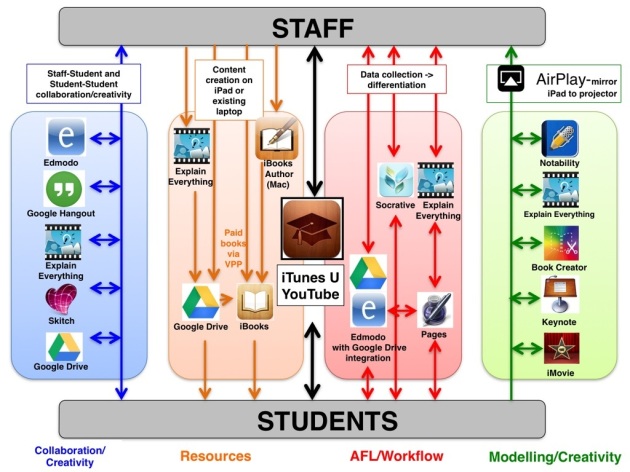The iPad Toolkit for Learning?
July 3, 2013 29 Comments
THE STARTING POINT?
It is interesting to reflect how this simplification of iPad key tools has changed in a relatively short space of time. iWork suite aside, you could purchase the above apps for less than the cost of a textbook and have a model that could enhance learning with the right application.
For those educators who are using iPads in the classroom, the suggestions above will be nothing new. The hope is that other educators will not feel overwhelmed by the diagram and actually view a number of core apps as manageable for their own learning curve.
It must be said that there are a number of applications that I could happily add to the diagram that would be useful for the toolkit. For example, Showbie (a way of collecting, assessing and handing back student work) would certainly meet the requirements of many iPad learning environments. The point is that less than 15 apps can be a starting point for learning, with the substitution of applications based on the learner’s needs and educator’s requirements. I have had many conversations with educators who feel that the pedagogical shift and adaptation to the new technology can be intimidating. The diagram above serves to reduce that feeling and start a conversation moving forward with increased technology use in the classroom.
KEY CONSIDERATIONS
You will notice that Google Drive and Explain Everything are an integral part of the learning process. A centralised store with the ability to share folders and information is crucial for educators and students alike. Google Drive has been chosen as it allows 30GB of free storage for every user. You must be registered as a Google Apps For Education institution.
Explain Everything serves as a platform to enhance and demonstrate learning. It has been written about many times as the go-to app for education. However, it is only as good as the user. The educator can record screencasts, transform feedback and personalise learning with it. Students can demonstrate learning, collaborate, create and feedback as well as export their work to their required destination.
The rest of the tools have creation and collaboration at their core alongside the assessment for learning with feedback mechanisms. It is my intention to blog about these processes, as their use develops in our own 1:1 iPad environment and I welcome any input. Any of the apps recommended above are well worth looking into and are suggested after much discussion and debate.
(Incidentally, I am a firm believer that Augmented Reality will play a significant role in education. Consequently I am using Aurasma to enhance learning in the classroom. I would have included it in this toolkit but feel I need to explore its potential a little further. Needless to say, it is well worth looking into if you are fortunate enough to have the technology available).
-with thanks to Greg Hughes @deepexperience1


